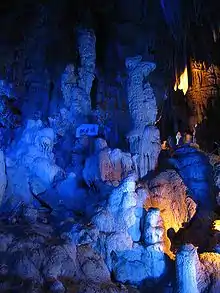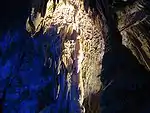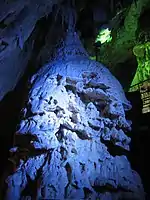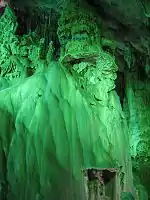Abukuma-do
Abukuma-do (あぶくま洞 - Abukuma Cave) is a limestone cave located in Fukushima Prefecture, Japan. The cave was discovered on August 15, 1969, northeast of the city of Tamura and was originally named Kamayama Shonyu-do (釜山鍾乳洞). It was designated a natural heritage of the town on February 7, 1971, and renamed Abukuma-do on June 1, 1973.[1] Visitors can traverse a 600-metre-long path inside the cave as well as a 120-metre-long exploration course to view the stalactites and stalagmites. Each stalactite has taken more than eighty million years to form.[2] Beyond the public areas lie about 2,500 metres of cave that are not open to the public. Nearby Abukuma Cave is the smaller Irimizu Shonyu-do (入水鍾乳洞 - Irimizu Limestone Cave), discovered in 1927. Irimizu Limestone Cave was designated a National Natural Treasure on December 28, 1934.[3] The temperature inside Abukuma-do is around 15 °C and the humidity is above 90%.
| Abukuma-do | |
|---|---|
 The Takine Palace | |
| Location | Honshū, Japan |
| Nearest city | Tamura-shi, Fukushima Prefecture |
| Coordinates | 37°20′41″N 140°40′24″E |
| Visitors | 10,085,000 (in 1988) |
History
Abubukuma-dong was discovered in September 1969 from the present Busan quarry site in an area called Abukuma Highlands (阿武隈高地), or Harachitai highlands (原地帯), in the middle of a plateau of geologic formation of irregular limestone deposits, on the west side slope of Mt. Otakine. Since ancient times mining for marble and limestone has been popular in that area. Limestone was also discovered at Abukuma-do. At the year of Abukuma-do's discovery mining in that area was suspended, and a limestone outcrop remains to this day near its parking lot.
The initial discovery of an entrance to the cave is now near the exit of the modern day tourist destination. The cave itself consists of a 12m deep hole, a tunnel running 60m north, and a tunnel running 15m southwest. In March 1970 the Japanese university 's expedition team explored the inside of the cave, and found a main cave ahead of the air hole in the northern end that was regarded as the end point until then. In 1973, four years after the discovery, the inside of the cave was developed for observation and it was opened to the public.
Boxwork

A notable feature of Abukuma-do is the existence of boxwork, a rare cave formation composed of thin blades of the mineral calcite that project from cave walls and ceilings, forming a honeycomb or box-like pattern. Boxwork can also be found in Shimukugama in Okinawa and Sugawatari-do (氷渡洞 - Ice Cross Cave) in Iwate Prefecture, but because Abukuma-do is currently the only limestone cave in Japan open to tourists, it is subsequently the only cave in Japan in which boxwork can be seen.
Christmas Tree and Silver Frost

The Christmas Tree and the Silver Frost are two of the most distinctive Speleothem inside Abukuma-do. The Christmas Tree is a stalagmite and The Silver Frost meets dripstones on the roof of the cave resulting in an impressive column. Both represent a featured stop along the 600 meter course inside the cave. According to the Abukuma Caves Management Office, The Christmas Tree, at over two metres high,[4] is said to be the largest stalagmite in the East.
Notes
- Suzuki K., page 17.
- Takeda T.:Hello! Fukushima, page 116.
- Takeda T.:Fukushima - Today & Tomorrow, page 50.
- Suzuki K., page 31.
References

- Takeda, Toru; Hishinuma, Tomio; Kamieda, Kinuyo; Dale, Leigh; Oguma, Chiyoichi (August 10, 1988), Hello! Fukushima - International Exchange Guide Book (1988 ed.), Fukushima City: Fukushima Mimpo Press
- Takeda, Toru; Hishinuma, Tomio; Oguma, Chiyoichi; Takiguchi, R. (July 7, 2001), Fukushima - Today & Tomorrow, Aizu-Wakamatsu City: Rekishi Shunju Publishing Co., ISBN 4-89757-432-3
- Suzuki, Katsuji (1993), Abukuma Cave, Irimizu Limestone Cave, Takine Town: Suzuya
External links
- (in Japanese) Tamura City official website